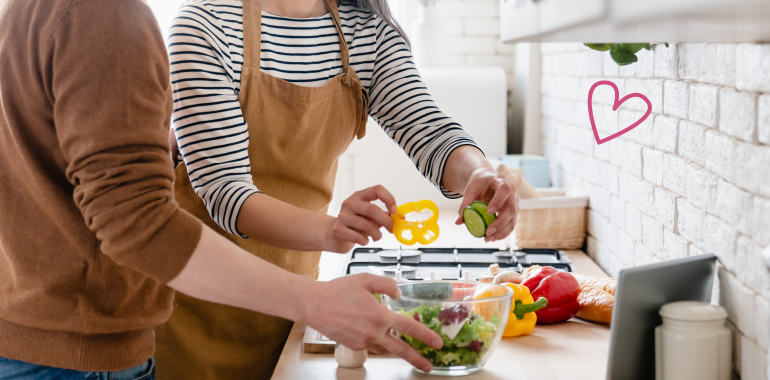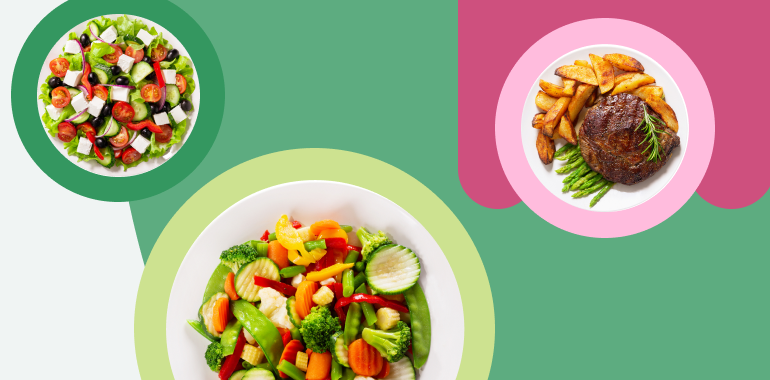Table Of Contents
Join Clean Eating Challenge – Revamp Your Plate, Transform Your Shape!
Do you feel stuck in a nutritionally unbalanced cycle? Looking for an enjoyable way to break unhealthy habits and implement healthier options into your daily routine? Then join our clean eating challenge! I’ll assist you in creating delicious and simple recipes that will enable you to make wise decisions regarding your diet. By focusing on whole foods and nutritious ingredients, you can reduce processed meals in your diet!
Whether you’re trying something new or simply listening to what your body needs – give yourself a chance to explore fresh flavors while enjoying healthy fare. Start your journey toward better nutrition with this clean eating challenge today!
What is a Clean Eating Challenge?
Imagine your body as a high-performance vehicle. To keep it running smoothly, you need to fuel it with premium ingredients. A clean eating challenge is like putting high-quality fuel into your vehicle – it’s all about choosing wholesome, natural foods and minimizing processed ones for a specific period.
Clean eating isn’t a diet in the traditional sense but a lifestyle approach to food, leading to improved health and well-being. The key lies in increasing intake of the healthiest food choices from each food group while reducing consumption of less healthy options. During a clean eating challenge, you commit to following these principles for a set timeframe, typically 30 days, to establish healthier eating habits.

Benefits of a 30 Day Clean Eating Challenge
Committing to a 30 day clean eating challenge can transform your health in remarkable ways. In just one month of clean eating, you might experience significantly increased energy levels as your body receives proper nutrition without processed sugar crashes. Many participants report clearer skin as they eliminate inflammatory foods and increase hydration.
Weight management becomes more natural as you fill up on nutrient-dense foods rather than empty calories. Your digestive system thanks you with improved function when you increase fiber intake and remove artificial ingredients. Mental clarity often improves too, with many challengers reporting better focus and reduced brain fog.
Perhaps most importantly, a 30-day challenge helps establish sustainable habits that can extend beyond the challenge period. It’s long enough to break old patterns but not so overwhelming that it feels impossible. The structured timeframe provides clear beginning and endpoints, making the commitment feel achievable.
Clean Eating Principles to Transform Your Diet
Clean eating isn’t complicated once you understand the core principles. First, prioritize whole, unprocessed foods – items that closely resemble their natural state. Think fresh produce, whole grains, and lean proteins rather than packaged goods with long ingredient lists.
Read food labels diligently. If you can’t pronounce an ingredient or wouldn’t find it in your kitchen, consider whether that product deserves a place in your shopping cart. Simple ingredients signal cleaner options.
Hydration plays a crucial role in clean eating. Make water your primary beverage and limit or eliminate sugary drinks, including fruit juices with added sugars. Proper hydration supports every bodily function and helps you distinguish between hunger and thirst, which many people confuse.
Cook at home whenever possible. This gives you complete control over ingredients and preparation methods. When you prepare meals yourself, you’ll naturally use fewer preservatives, artificial flavors, and unhealthy fats than commercially prepared foods.
Practice mindful eating by paying attention to hunger cues and stopping when satisfied, not stuffed. This approach honors your body’s wisdom and prevents overeating clean foods, which can still contribute to weight gain if consumed in excess.
Nature’s Bounty: List of Clean Foods
This list is based on the general principles of clean eating, which encourage consuming foods that are minimally processed and free from artificial additives.
Nutrient-rich Fruits for a Clean Diet
1. Apples
2. Oranges
3. Berries
4. Bananas
5. Kiwis
Ideal Vegetable Choices
1. Spinach
2. Kale
3. Swiss Chard
4. Romaine Lettuce
5. Broccoli
6. Cauliflower
7. Brussels Sprouts
8. Bell Peppers
9. Carrots
10. Tomatoes
Whole Grains: Fueling Your Body
1. Quinoa
2. Brown Rice
3. Oats
4. Barley
Lean Proteins – Power Up Your Plate
1. Skinless Chicken Breast
2. Turkey
3. Fish (Salmon, Tuna, etc.)
4. Lentils
5. Chickpeas
6. Tofu
Healthy Fats – Lip-Smacking Goodness
1. Avocado
2. Nuts and Seeds
3. Olive Oil
Clean Dairy Substitutes for Lactose Intolerant Persons
1. Almond Milk
2. Coconut Milk
3. Oat Milk
Natural Sweeteners for Clean Desserts
1. Honey
2. Maple Syrup
3. Stevia
4. Date Syrup
5. Coconut Sugar
Fresh Journey to Eating Clean for Beginners
Decode the Clean Eating Lingo
Clean eating isn’t about soap and water! It’s about whole, natural foods that are minimally processed and close to their original form.
Whole Foods are the Whole Deal
Imagine your plate as a canvas painted with fruits, veggies, lean proteins, whole grains, and healthy fats – a masterpiece of nutrients!
Become a Label Detective
Ingredient lists shouldn’t sound like a science experiment. Short and pronounceable is the way to go when checking food labels.
Hydration Nation
Make water your go-to beverage. It’s your skin’s best friend, digestion ally, and appetite counselor.
Home is Where the Health is
Cooking at home gives you total control over your food. Plus, it’s as satisfying as finishing a jigsaw puzzle.
Portion Control Patrol
Even on a clean eating journey, too much of a good thing can be harmful. Learn to recognize your body’s hunger and fullness signals.
Meal Plan Magic
By planning your meals, ward off unhealthy last-minute choices. It’s like having a health-friendly crystal ball!
Savvy Shopper
Be a grocery store explorer – stick to the perimeter where the treasures of fresh produce, meats, and dairy are found.
Sugar, Not-So-Sweet
Sugar lurks in unexpected places. Cutting back can boost your energy and give your health a boost.
Eat a Rainbow
Who needs a pot of gold? The real treasure is the different nutrients each color of fruit and vegetable provides.
Hold the Salt
High sodium levels can bloat your body and strain your heart. Instead, experiment with herbs and spices, and let your taste buds go on an adventure.
Snack Smarts
Keep clean snacks like fruits, nuts, or yogurts close by to avoid reaching for processed alternatives.
Take Baby Steps
You’re running a marathon, not a sprint. Small, consistent changes will get you to the finish line.

30 Day Clean Eating Challenge Meal Plan
A clean eating challenge meal plan takes the guesswork out of your health journey. I’ve designed this 30-day roadmap to gradually introduce clean eating principles, making the transition smoother and more sustainable. Each week builds upon the previous one, allowing your taste buds and habits to adjust naturally.
Week 1: Getting Started with Clean Eating
The first week focuses on simple substitutions rather than complete overhauls. Replace refined grains with whole grains like brown rice instead of white, or whole wheat pasta instead of regular. Begin reducing added sugars by cutting back on sweetened beverages and opting for fruit-infused water instead.
Increase your vegetable intake by adding one extra serving at lunch and dinner. Start reading food labels and familiarize yourself with hidden ingredients to avoid. Plan for success by meal prepping breakfast and lunch for the workweek.
Week 2: Building Momentum with Nutritious Recipes
Now that you’ve adjusted to initial changes, take things up a notch. Eliminate processed snacks completely and replace them with whole food alternatives like fruit with nut butter, veggie sticks with hummus, or a small handful of mixed nuts.
Focus on protein quality by choosing organic or grass-fed options when possible. Experiment with plant-based protein sources for at least three meals this week. Try new herbs and spices to add flavor without sodium or artificial ingredients.
Week 3: Advancing Your Clean Eating Journey
By week three, your palate is adjusting to cleaner flavors. Now’s the time to tackle emotional eating habits by identifying triggers and developing alternative coping strategies. Eliminate refined sugars completely and experiment with natural sweeteners like honey or maple syrup in moderation.
Practice mindful eating at every meal – no screens, slow chewing, and paying attention to hunger cues. Try batch cooking to prepare multiple clean meals at once, saving time later in the week.
Week 4: Mastering Clean Eating Habits
The final week solidifies your new lifestyle. Focus on fine-tuning portion sizes based on your body’s needs. Introduce intermittent fasting if it suits your lifestyle – perhaps a 12-hour overnight fast to support digestion.
Get creative with “clean” versions of your favorite treats so you don’t feel deprived. Assess how different foods affect your energy, mood, and digestion through a food journal. Plan for social situations and eating out with strategies to maintain your clean eating habits.
This 30-day progression helps establish sustainable habits rather than temporary fixes. The clean eating challenge meal plan provides structure while allowing flexibility to adapt to your personal preferences and lifestyle.
7 Day Clean Eating Meal Plan – Revitalize Your Health
Day 1: Welcome to Whole Foods
- Breakfast: Jump-start your day with a protein-packed omelet. Add spinach, tomatoes, and a sprinkle of cheese.
- Lunch: A refreshing Greek salad loaded with cucumbers, tomatoes, olives, and feta, paired with grilled chicken.
- Dinner: Steamed salmon with a side of quinoa and roasted veggies.
Day 2: Rainbow Plate Parade
- Breakfast: An energizing berry and spinach smoothie.
- Lunch: Bright bell pepper and black bean quinoa salad.
- Dinner: Rainbow stir-fry with a mix of colorful veggies and lean protein like tofu or chicken.
Day 3: Fiberlicious Feast
- Breakfast: Heart-healthy bowl of oatmeal topped with fresh fruits and a drizzle of honey.
- Lunch: A bowl of lentil soup paired with whole-grain toast.
- Dinner: Sweet potato and black bean tacos with a dollop of Greek yogurt.
Day 4: Hydrate Your Plate
- Breakfast: A hydrating smoothie made with cucumber, mint, and pineapple.
- Lunch: Zesty shrimp and avocado salad.
- Dinner: Lemon and dill baked salmon with a side of steamed veggies.
Day 5: Plant Power
- Breakfast: A delightful acai bowl topped with banana slices, coconut shavings, and a sprinkle of chia seeds.
- Lunch: Flavorful chickpea curry with brown rice.
- Dinner: Baked portobello mushroom caps stuffed with spinach and cheese.
Day 6: Lean Protein Power
- Breakfast: Greek yogurt parfait with mixed berries and granola.
- Lunch: Turkey lettuce wraps with a side of fresh veggies.
- Dinner: Grilled chicken breast with a side of quinoa salad.
Day 7: Hello, Healthy Fats
- Breakfast: Avocado and poached egg toast.
- Lunch: Wild rice and salmon salad with a drizzle of olive oil.
- Dinner: Baked fish with a side of mixed nuts and roasted veggies.
This 7-day clean eating meal plan isn’t just about eating right. It’s about experiencing the joys of nutritious and delicious foods. It’s like a vacation for your body where the souvenirs are radiant health and renewed vitality. So here’s to savoring every bite and revitalizing your health, one meal at a time!
Weight Loss Results from Clean Eating Challenge
Clean eating can lead to impressive weight loss results, but the journey is different for everyone. The most significant advantage is that clean eating promotes sustainable weight management rather than rapid, temporary losses. When you eliminate processed foods, excess sugars, and artificial ingredients, your body naturally finds its optimal weight.
Many participants report losing between 5-10 pounds during a 30-day clean eating challenge. However, the number on the scale doesn’t tell the whole story. Clean eating often results in improved body composition – less fat, more muscle – which may not always reflect dramatically on the scale but shows in how clothes fit and how energetic you feel.
7 Days Weight Loss Challenge – Trim & Thrive
Day 1: Detox Joy
Kickstart your weight loss journey by hydrating and detoxifying your body. Start the day with a glass of warm water and lemon. Stick to lean proteins, a rainbow of veggies, and whole grains for meals. Avoid processed foods and added sugars, and limit your salt intake.
Day 2: Protein Paradise
Today is all about protein, the building block of life that helps manage weight. Start with scrambled eggs or a protein smoothie for breakfast. Lunch could be a grilled chicken salad, and for dinner, try baked salmon with steamed veggies. Don’t forget to drink plenty of water!
Day 3: Fiber Feast
Give a shout-out to fiber, your digestive system’s best friend and a natural hunger suppressant. Think oatmeal for breakfast, lentil soup for lunch, and a big, colorful veggie stir-fry with brown rice for dinner. Fruits like apples and pears make great snacks!
Day 4: Unprocessed Universe
A day dedicated to going as naturally as possible. Avoid anything that comes in a packet, can, or box. Fresh fruits & vegetables are today’s stars. How about a tasty fruit salad, quinoa with grilled vegetables, and a lean turkey wrap?
Day 5: Healthy Fats Fiesta
Healthy fats are not to be feared. They’re essential for your body and help you feel full longer. Avocado toast for breakfast, a salad with olive oil dressing for lunch, and grilled fish with mixed nuts for dinner would be perfect.
Day 6: Color Carnival
Celebrate the phytonutrients that come with colorful fruits and veggies. Start with a berry smoothie, enjoy a vibrant salad for lunch and dinner, and how about a rainbow stir-fry? Each color brings a different set of nutrients to the table.
Day 7: Mindful Munching
Today is about slowing down and truly savoring your food. Chew thoroughly and pay attention to your hunger and fullness cues. Practice portion control, but don’t deprive yourself. Start with Greek yogurt and honey, have a chicken and veggie wrap for lunch, and end with a hearty vegetable soup for dinner.
Real Success Stories
Sarah, a 32-year-old teacher, lost 8 pounds during her 30-day clean eating challenge. More importantly, she reported that her chronic headaches disappeared and her skin cleared up significantly. “I didn’t even realize how bad I felt until I started feeling good,” she shared.
Michael, a 45-year-old accountant, didn’t focus on the scale but noticed his belt needed tightening by two notches after his challenge. His cholesterol levels also improved dramatically, and his doctor reduced his medication dosage.
Jamie, a college student, combined clean eating with regular exercise and lost 12 pounds in 30 days. “The biggest change was my energy level,” she noted. “I used to crash every afternoon, but now I can stay focused all day.”
Easy Clean Eating Lunch Ideas – Your Power-Packed Fuel
Quinoa Salad Superstar
Combine cooked quinoa with a rainbow of veggies like cucumbers, cherry tomatoes, bell peppers, and a sprinkling of feta cheese. Dress it with lemon and a drizzle of olive oil for a protein-packed, fiber-rich lunch.
Buddha Bowl Bliss
Start with brown rice or quinoa. Top it with a mix of raw and roasted veggies, a serving of protein like tofu or chicken, and a sprinkle of seeds or nuts. Drizzle your bowl with a tasty, homemade dressing like tahini or a light vinaigrette.
Avocado Chicken Wraps
Whole grain tortilla wraps filled with grilled chicken, ripe avocado slices, lettuce, and some Greek yogurt for creaminess. They’re healthy, satisfying, and perfect for on-the-go! Moreover, they also can be a part of clean eating ideas for breakfast!
Soup-er Veggie Soup
A warm bowl of homemade vegetable soup is perfect for a light lunch. Use whatever veggies you have on hand, add some beans for protein, and season with herbs and spices.
Sweet Potato Powerhouse
Roast sweet potato and fill it with a mix of black beans, corn, chopped tomatoes, and cilantro. Top it off with a dollop of Greek yogurt for a nutrient-packed lunch.
Terrific Turkey Lettuce Wraps
Wrap lean ground turkey sautéed with onions, bell peppers, and seasonings in crisp lettuce leaves for a low-carb yet flavorful lunch.
Pesto Pasta Primavera
Toss whole grain pasta with a bounty of sautéed seasonal vegetables and a swirl of homemade pesto. Add grilled shrimp or chicken for a hearty and clean lunch.
Super-Power Clean Eating Family Recipes
These dishes are so delicious and nutritious that your family will run to the table faster than a speeding bullet!
Mega Meatball Spaghetti Squash
Trade traditional pasta for spaghetti squash, a vitamin-packed alternative. Top the roasted squash strands with homemade lean turkey meatballs and a robust marinara sauce. It’s a meal that will give your family the strength of superheroes!
Power Packed Stir-fry
Create a vibrant stir-fry using colorful vegetables – think red bell peppers, orange carrots, yellow corn, green broccoli, and purple cabbage. Add tofu or lean chicken for protein, and serve it over brown rice. It’s as energizing as lightning!
Mighty Greek Pita Pockets
Stuff whole wheat pita pockets with Greek-inspired ingredients like grilled chicken, tomatoes, cucumbers, olives, and feta cheese. Top it with a homemade tzatziki sauce for a lunch that’s as mighty as a Greek god!
Captain’s Catch Tuna Salad
This isn’t your average tuna salad! Mix canned tuna with Greek yogurt, lemon juice, and a splash of Dijon mustard. Toss in some chopped celery and onions for a little crunch. Serve over a bed of crisp lettuce or in a whole-grain wrap for a protein-packed lunch!
Galactic Grilled Cheese
Reinvent the traditional grilled cheese using whole-grain bread and adding sliced tomato and avocado to your favorite low-fat cheese. Combine it with a serving of fresh tomato soup made at home for a satisfying lunch that is simply out of this world!

How to Stick With Your Clean Eating Challenge
Sticking with a clean eating challenge requires strategy and mindset shifts. First, start by setting realistic expectations. Perfect adherence isn’t the goal – progress is. Allow yourself occasional flexibility without viewing it as “cheating” or failure.
Preparation prevents poor performance. Spend a few hours each week meal prepping so you’ll have clean options ready when hunger strikes. This simple habit dramatically increases your chances of success.
Find accountability through a challenge buddy or online community. Sharing your journey makes the experience more enjoyable and provides support during difficult moments. Document your progress with photos or a journal to visualize your improvements when motivation wanes.
Identify your personal triggers for unhealthy eating and develop specific strategies to address them. For stress eating, perhaps substitute a short walk or breathing exercise. For social pressure, practice polite ways to decline food that doesn’t align with your goals.
Focus on adding rather than subtracting. Instead of dwelling on foods you’re avoiding, celebrate all the nutritious new options you’re discovering. This positive framing makes the challenge feel abundant rather than restrictive.
Finally, remember your “why.” Connect daily with your deeper motivation for undertaking this challenge, whether it’s increased energy, better health markers, or setting an example for your family. This emotional connection will fuel your commitment when willpower alone isn’t enough.
Frequently Asked Questions About Clean Eating
Q1: What are some examples of Clean Foods?
Clean foods include nutrient-rich fruits like apples, oranges, berries, bananas, and kiwis. Ideal vegetable choices such as spinach, kale, Swiss chard, romaine lettuce, broccoli, and bell peppers. Whole grains like quinoa, brown rice, oats, and barley. Lean proteins such as skinless chicken breast, turkey, fish (salmon, tuna), lentils, and tofu. Healthy fats like avocado, nuts and seeds, and olive oil are also considered clean.
Q2: What are the fundamental principles of Clean Eating?
The key principles include choosing minimally processed, natural foods; prioritizing whole foods from each food group; minimizing the consumption of unhealthy options; reading and understanding ingredient lists; staying hydrated with water as the primary beverage; cooking and preparing meals at home; practicing portion control and mindful eating.
Q3: What is the Clean Eating Challenge?
It’s a program designed to help individuals revamp their plates and transform their shapes through clean eating principles. It provides participants with guidance, support, and resources to adopt a healthy eating lifestyle.
Three important points about it:
- The program focuses on clean eating principles.
- It provides guidance, support, and resources.
- It helps individuals transform their shapes through healthy eating.
Q4: How long does the Join Clean Eating Challenge last?
The Join Clean Eating Challenge typically lasts for 30 days. This duration allows participants to establish new eating habits and experience the benefits of clean eating over an extended period.
Q5: Who can participate in the Join Clean Eating Challenge?
The challenge is open to everyone who is committed to improving their health and well-being through clean eating. Whether you are a beginner or have prior experience with healthy eating, you can participate in this clean eating challenge.
My name is Barbara Kovalenko. I hold a Bachelor's degree in Human Nutrition from Bogomolets National Medical University in Ukraine and a Master's degree from Boston University in the United States. Over the past few years, I have gained valuable experience as a nutritionist and have since decided to share my knowledge and expertise with a wider audience. Currently, I am working as a nutritional consultant with the Lasta app.










What a fantastic initiative! I’m excited to embrace healthier choices and explore the delicious recipes you’ve shared in this clean eating challenge for weight loss.
Hello, Mia!
Thank you so much for your positive and enthusiastic response! 🌱💪